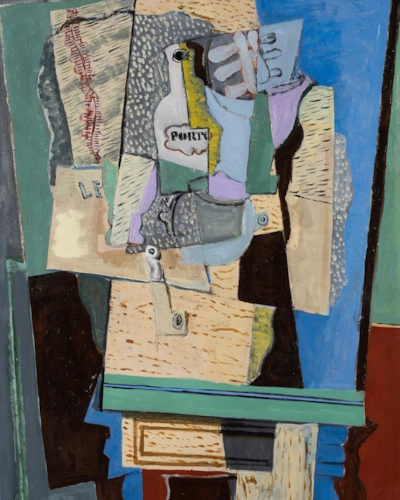Pablo Picasso
1881 - 1973
Tasse et bananes
27 x 21.3 cm (10 ⁵/₈ x 8 ³/₈ inches)
Signed on the reverse, Picasso
Executed in 1908

Roger Dutilleul, Paris
Galerie Louise Leiris, Paris
Eugene and Dorothy Prakapas, New York, acquired from the above in November 2000
Private collection, New York, thence by descent
Pierre Daix and Joan Rosselet, Picasso: The Cubist Years 1907–1916, A Catalogue Raisonné of the Paintings and Related Works, London, 1979, no. 208, p. 229 (illustrated; titled Cup and Fruit)
Christian Zervos, Pablo Picasso. Œuvres de 1906 à 1912, vol. 2, Paris, 1986, no. 100, pp. 48, 175 (illustrated p. 48)
Josep Palau i Fabre, Picasso Cubism (1907–1917), New York, 1990, no. 295, pp. 107, 499 (illustrated p. 107; titled Cup and Tuber; dated 1909)
Pablo Picasso
biography
Exceptionally prolific throughout the course of his long life, Picasso achieved universal renown and immense fortune for his revolutionary artistic accomplishments; known for co-founding the Cubist movement, inventing constructed sculpture and co-inventing collage. Picasso's work is often categorized into periods, most commonly accepted as the Blue Period (1901–1904), the Rose Period (1904-1906), the African Period (1907-1909), Analytical Cubism (1909-12) and Synthetic Cubism (1912-19). Some of his work dating from the 1910s and much dating from the early 1920s were executed in a Neoclassical style. Picasso’s work from the mid-1920s often possesses the characteristics of Surrealism, whilst his later work combines elements of his earlier styles. Among his most famous and iconic works are the proto-Cubist Les Demoiselles d’Avignon (1907) inspired by Iberian and African sculpture; and Guernica (1937) a haunting poem on the Fascist bombing of a Basque town during the Spanish Civil War.
At the time of Picasso's death many of his paintings were in his possession. In addition, Picasso had a considerable collection of the work of other famous artists, some his contemporaries, such as Henri Matisse with whom he has exchanged works. Since Picasso left no will, his death duties (estate tax) to the French state were paid in the form of his works and others from his collection. It is these works that form the core of the immense and representative collection of the Musée Picasso in Paris. As of 2004, Picasso remained the top-ranked artist (based on sales of his works at auctions) and on 21 June 2016 a painting by Pablo Picasso titled Femme Assise (1909) sold for £43.2 million ($63.4 million) at Sotheby's in London, setting a world record for the highest price ever paid at auction for a Cubist work.
Pablo Picasso
biography
you may also like
1830 - 1903
La Place du Havre, Effet de Pluie
33 x 41 cm (13 x 16 ¹/₈ inches)
1876 - 1958
Le Guéridon au vase de fleurs
64 x 51.5 cm (25 ¹/₄ x 20 ¹/₄ inches)
1830 - 1903
L'Anse des Pilotes, après-midi, temps ensoleillé, Le Havre
46 x 55 cm (18 ¹/₈ x 21 ⁵/₈ inches)
1863 - 1935
Bourg-Saint-Andéol. Le Pont
28.2 x 46.5 cm (11 ¹/₈ x 18 ¹/₄ inches)
1878 - 1941
Instrument de musique sur guéridon
80.5 x 52.7 cm (31 ³/₄ x 20 ³/₄ inches)















_1552024T121340.167.jpg?width=1500&height=1500&quality=100&mode=max&scale=both)




